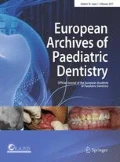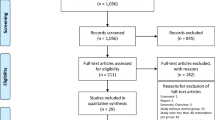Abstract
Aim: To review the available literature on the durability of amalgam when used to restore interproximal (class II) cavities in primary molars. Methods: The literature was searched using OVID Medline and EMBASE from 1966 to 2006. The search plan of the electronic databases included: “dental amalgam or amalgam or alloy” and “deciduous or primary or milk or first or baby or natal” or “tooth or teeth or dentition” and “permanent restorations or permanent fillings”. Relevant prospective clinical studies were reviewed by 2 reviewers against a set of defined criteria. Papers were graded according to the number of criteria met as A = >90%, B1 = 75%, B2 = 50% and C = <50%. Results:: No study achieved a Grade A; four studies rated Grade B1 and thirteen B2. Seven studies were rated Grade C. A wide range of failure rates for amalgam were reported from 0–58%. However, in the context of a controlled clinical environment in a developed country the failure rate varied between 0 and 22%. Conclusion: Amalgam remains an appropriate choice of material for the restoration of the primary dentition. However, factors other than durability are increasingly influencing its use in clinical practice.
Similar content being viewed by others
References
AAPD. Guideline on pediatric restoration dentistry. Pediatr Dent. 2005–6; Reference Manual: 122–129.
Barr-Agholme M, Oden A, Dahllof G, Modeer T. A two-year clinical study of light-cured composite and amalgam restorations in primary molars. Dent Mater. 1991;7: 230–3.
Braff MH. A comparison between stainless steel crowns and multisurface amalgams in primary molars. J Dent Child. 1975;42: 474–8.
Chadwick BL, Evans DJR Restoration of class II cavities in primary teeth with conventional and resin modified glass ionomer cements: An evidence based assessment of the literature. Eur Arch Paed Dent. 2007; 1:13–20.
Chu CH, King NM, Lee AM, Yiu CK, Wei SH. A pilot study of the marginal adaptation and surface morphology of glass-cermet cements. Quintessence Int. 1996;27: 493–501.
Curzon ME, Toumba KJ. Restoration of primary teeth: clinical criteria for assessment of the literature. Eur Arch Paed Dent. 2006;7: 48–52.
Cvar JF, Ryge G. Criterion for the clinical evaluation of dental restorative materials. 1971;USPHS Publication No 790-244.
Dawson LR, Simon JR Jr., Taylor PP. Use of amalgam and stainless steel restorations for primary molars. J Dent Child. 1981;48: 420–2.
Donly KJ, Segura A, Kanellis M, Erickson RL. Clinical performance and caries inhibition of resin-modified glass ionomer cement and amalgam restorations. J Am Dent Assoc. 1999;130: 1459–66.
Duggal MS, Toumba KJ, Sharma NK. Clinical performance of a compomer and amalgam for the interproximal restoration of primary molars: a 24-month evaluation. Br Dent J. 2002;193: 339–42.
Frencken JE, Makoni F. Sithole WD. Atraumatic restorative treatment and glass-ionomer sealants in a school oral health programme in Zimbabwe: evaluation after 1 year. Caries Res. 1996;30: 428–33.
Fuks AB, Araujo FB, Osorio LB, Hadani PE, Pinto AS. Clinical and radiographic assessment of Class II esthetic restorations in primary molars. Pediatr Dent. 2000;22: 479–85.
Gordon M, Gorfil C, Segal S, Mass E. Treatment policies among Israeli specialists in paediatric dentistry. Europ J Paediatr Dent. 2005;6: 73–8.
Hickel R, Voss A. A comparison of glass cermet cement and amalgam restorations in primary molars. J Dent Child. 1990;57: 184–8.
Holland IS, Walls AW, Wallwork MA, Murray JJ. The longevity of amalgam restorations in deciduous molars. Br Dent J. 1986;161: 255–8.
Honkala E, Behbehani J, Ibricevic H, Kerosuo E, Al-Jame G. The atraumatic restorative treatment (ART) approach to restoring primary teeth in a standard dental clinic. Int J Paediatr Dent. 2003;13: 172–9.
Kavvadia K, Kakaboura A, Vanderas AP, Papagiannoulis L. Clinical evaluation of a compomer and an amalgam primary teeth class II restorations: a 2-year comparative study. Pediatr Dent. 2004;26: 245–50.
Kotsanos N, Dionysopoulos P. Lack of effect of fluoride releasing resin modified glass ionomer restorations on the contacting surface of adjacent primary molars: a clinical prospective study. Europ J Paediatr Dent. 2004;5: 136–142.
Levering NJ, Messer LB. The durability of primary molar restorations: I. Observations and predictions of success of amalgams. Pediatr Dent. 1988; 10: 74–80.
Llewelyn DR. A pilot study of 230 restorations in children’s mouths. Proc Br Paedod Soc. 1977;7: 19–21.
Marks LA, Weerheijm KL, van Amerongen WE, Groen HJ, Martens LC. Dyract versus Tytin Class II restorations in primary molars: 36 months evaluation. Caries Res. 1999;33: 387–92.
Mass E, Gordon M, Fuks AB. Assessment of compomer proximal restorations in primary molars: a retrospective study in children. J Dent Child. 1999;66: 93–7.
Milsom KM, Tickle M, Blinkhorn A. The prescription and relative outcomes of different materials used in general dental practice in the northwest region of England to restore the primary dentition. J Dent. 2002;30: 77–82.
Mitchell L, Walls AWG. Life survival analysis. Dent Update. 1991;18:125–128.
Morris ME, Barkin PR, Soelberg KB, Weis RW. Complex primary molar restorations using a composite resins. (A 42-month study using amalgam as comparative material). J Calif Dent Assoc. 1979;7: 39–42.
Nelson GV, Osborne JW, Gale EN, Norman RD, Phillips RW. A three-year clinical evaluation of composite resin and a high copper amalgam in posterior primary teeth. J Dent Child. 1980;47: 414–8.
NHMRC (1999) Dental amalgam and mercury in dentistry. National Health and Medical Research Council, Canberra, Australia.
Oldenburg TR, Vann WF, Jr., Dilley DC. Comparison of composite and amalgam in posterior teeth of children. Dent Mater. 1987;3: 182–6.
Ostlund J, Moller K, Koch G. Amalgam, composite resin and glass ionomer cement in Class II restorations in primary molars—a three year clinical evaluation. Swed Dent J. 1992;16: 81–86.
Papathanasiou AG, Curzon ME, Fairpo CG. The influence of restorative material on the survival rate of restorations in primary molars. Pediatr Dent. 1994;16: 282–8.
Peretz B, Ram D. Restorative material for children’s teeth: preferences of parents and children. J Dent Child. 2002;69: 243–248.
Petersson LG, Rasmusson CG, Hagborg S, Isacsson P. Fluoride supplemented and non gamma 2 amalgam. A comparative clinical study into the primary and permanent dentition in children. Swed Dent J. 1985;9: 49–53.
Peto R, Pike MC, Armitage P. Design and analysis of randomised clinical trials requiring prolonged observation of each patient. II. Analysis and examples. Br J Cancer. 1977;35: 1–39.
Qvist V, Thylstrup A, Mjor IA. Restorative treatment pattern and longevity of amalgam restorations in Denmark. Acta Odontol Scand. 1986;44: 343–9.
Qvist V, Laurberg L, Poulsen A, Teglers PT. Longevity and cariostatic effects of everyday conventional glass-ionomer and amalgam restorations in primary teeth: three-year results. J Dent Res. 1997;76: 1387–96.
Qvist V, Laurberg L, Poulsen A, Teglers PT. Eight-year study on conventional glass ionomer and amalgam restorations in primary teeth. Acta Odontol Scand. 2004;62: 37–45.
Roberts JF, Sherriff M. The fate and survival of amalgam and preformed crown molar restorations placed in a specialist paediatric dental practice.[erratum appears in Br Dent J. 1990 Nov 10;169(9): 285.
Roberts MW, Broring CL, Moffa JP. Two-year clinical evaluation of a proprietary composite resin for the restoration of primary posterior teeth. Pediatr Dent. 1985;7: 14–8.
Roshan D, Curzon ME, Fairpo CG. Changes in dentists’ attitudes and practice in paediatric dentistry. Europ J Paediatr Dent. 2003;4: 21–7.
Rugg-Gunn AJ, Welbury RR, Toumba J, British Society of Paediatric D. British Society of Paediatric Dentistry: a policy document on the use of amalgam in paediatric dentistry. Int J Paediatr Dent. 2001;11: 233–8.
Taifour D, Frencken JE, Beiruti N, van’t Hof MA, Truin GJ. Effectiveness of glass-ionomer (ART) and amalgam restorations in the deciduous dentition: results after 3 years. Caries Res. 2002;36: 437–44.
Tonn EM, Ryge G, Chambers DW. A two-year clinical study of a carvable composite resin used as class II restorations in primary molars. J Dent Child. 1980;47: 405–13.
Tran LA, Messer LB. Clinicians’ choices of restorative materials for children. Aust Dent J. 2003;48: 221–32.
Walls AW, Murray JJ, McCabe JF. The use of glass polyalkenoate (ionomer) cements in the deciduous dentition. Br Dent J. 1988;165: 13–7.
Welbury RR, Walls AW, Murray JJ, McCabe JF. The 5-year results of a clinical trial comparing a glass polyalkenoate (ionomer) cement restoration with an amalgam restoration. Br Dent J. 1991;170: 177–81.
Author information
Authors and Affiliations
Corresponding author
Rights and permissions
About this article
Cite this article
Kilpatrick, N.M., Neumann, A. Durability of amalgam in the restoration of class II cavities in primary molars: a systematic review of the literature. Eur Arch Paediatr Dent 8, 5–13 (2007). https://doi.org/10.1007/BF03262564
Published:
Issue Date:
DOI: https://doi.org/10.1007/BF03262564



